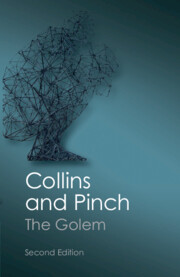Book contents
- Frontmatter
- Dedication
- Contents
- Preface to second edition
- Preface to first Canto edition
- Preface and acknowledgements
- Introduction: the golem
- 1 Edible knowledge: the chemical transfer of memory
- 2 Two experiments that ‘proved’ the theory of relativity
- 3 The sun in a test tube: the story of cold fusion 5
- 4 The germs of dissent: Louis Pasteur and the origins of life
- 5 A new window on the universe: the non-detection of gravitational radiation
- 6 The sex life of the whiptail lizard
- 7 Set the controls for the heart of the sun: the strange story of the missing solar neutrinos
- Conclusion: putting the golem to work
- Afterword: Golem and the scientists
- References and further reading
- Index
2 - Two experiments that ‘proved’ the theory of relativity
Published online by Cambridge University Press: 05 February 2014
- Frontmatter
- Dedication
- Contents
- Preface to second edition
- Preface to first Canto edition
- Preface and acknowledgements
- Introduction: the golem
- 1 Edible knowledge: the chemical transfer of memory
- 2 Two experiments that ‘proved’ the theory of relativity
- 3 The sun in a test tube: the story of cold fusion 5
- 4 The germs of dissent: Louis Pasteur and the origins of life
- 5 A new window on the universe: the non-detection of gravitational radiation
- 6 The sex life of the whiptail lizard
- 7 Set the controls for the heart of the sun: the strange story of the missing solar neutrinos
- Conclusion: putting the golem to work
- Afterword: Golem and the scientists
- References and further reading
- Index
Summary
INTRODUCTION TO PARTS 1 AND 2
Einstein's theory of relativity became widely known in the early part of the twentieth century. One of the reasons for its success among scientists was that it made sense of a number of puzzling observations. For example, the theory accounted for the orbit of the planet Mercury departing slightly from its expected path, and it made sense of a slight shift towards the red end of the spectrum which some had claimed to detect in the light coming from the sun. But the theory of relativity also achieved a popular success; it became the subject of newspaper headlines. This had something to do with the ending of the Great War and the unifying effect of science on a fractured continent. It had something to do with the dramatic circumstances and the straightforward nature of the 1919 ‘proof’ of relativity. And it undoubtedly had something to do with the astonishing consequences of the theory for our common-sense understanding of the physical world. When the implications of Einstein's insight – that the velocity of light must be constant whatever the velocity of the source – were worked out, strange things were predicted.
It turned out that, if Einstein's ideas are correct, time, mass, and length are not fixed but are relative to the speed at which things move. Things that go very fast – at speeds near to the velocity of light – would get very heavy and very short. People who travelled this fast would seem to everyone else to age slowly; identical twins could grow old at different rates if one stayed still and one went on a very rapid journey.
- Type
- Chapter
- Information
- The GolemWhat You Should Know About Science, pp. 27 - 56Publisher: Cambridge University PressPrint publication year: 2012



